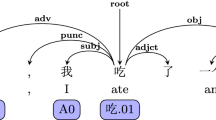Abstract
Most researches to SRL focus on English. It is still a challenge to improve the SRL performance of other language. In this paper, we introduce a two-pass approach to do Chinese SRL with a Recurrent Neural Network (RNN) model. We use English Proposition Bank (EPB) to improve the performance of Chinese SRL. Experimental result shows a significant improvement over the state-of-the-art methods on Chinese Proposition Bank (CPB), which reaches 78.39 % F1 score.
Access this chapter
Tax calculation will be finalised at checkout
Purchases are for personal use only
Similar content being viewed by others
Notes
- 1.
Conditional clause is seen as a semantic role in the Chinese but not in the English.
- 2.
PKU bilingual corpus is developed by Peking University, it is a English-Chinese parallel corpus. It contains 807,500 aligned English-Chinese sentence pairs and is available by licensing.
- 3.
We use GIZA++ to get the translation probability from PKU bilingual corpus, GIZA++ can be download in http://code.google.com/p/giza-pp/downloads/list.
References
Xue, N., Palmer, M.: Adding semantic roles to the Chinese Treebank. Nat. Lang. Eng. 15, 143–172 (2009)
Palmer, M., Gildea, D., Kingsbury, P.: The proposition bank: an annotated corpus of semantic roles. Comput. Linguist. J. 31, 71–106 (2005)
Gildea, D., Jurafsky, D.: Automatic labeling of semantic roles. Comput. Linguist. 28, 245–288 (2002)
Klementiev, A., Titov, I., Bhattarai, B.: Inducing crosslingual distributed representations of words. In: COLING (2012)
Zou, W.Y., Socher, R., Cer, D., Manning, C.D.: Bilingual word embeddings for phrase-based machine translation. In: The 2013 Conference on Empirical Methods in Natural Language Processing (EMNLP), pp. 1393–1398 (2013)
Hermann, K.M., Blunsom, P.: Multilingual models for compositional distributed semantics. In: ACL, pp. 58–68 (2014)
Chandar, S., Lauly, S., Larochelle, H., Khapra, M.M., Ravindran, B., Raykar, V.C., Saha, A.: An autoencoder approach to learning bilingual word representations. In: NIPS, pp. 1853–1861 (2014)
Koomen, P., Punyakanok, V., Roth, D., Yih, W.T.: Generalized inference with multiple semantic role labeling systems. In: The Ninth Conference on Computational Natural Language Learning, pp. 181–184. Association for Computational Linguistics (2005)
Collobert, R., Weston, J.: A unified architecture for natural language processing: deep neural networks with multitask learning. In: The 25th International Conference on Machine Learning, pp. 160–167. ACM (2008)
Xue, N., Palmer, M.: Automatic semantic role labeling for Chinese verbs. In: IJCAI, vol. 5, pp. 1160–1165. Citeseer (2005)
Xue, N.: Labeling Chinese predicates with semantic roles. Comput. Linguist. 34, 225–255 (2008)
Sun, W.: Semantics-driven shallow parsing for Chinese semantic role labeling. In: ACL, pp. 103–108 (2010)
Yang, H., Zong, C.: Multipredicate semantic role labeling. In: The 2014 Conference on Empirical Methods in Natural Language Processing (EMNLP), pp. 363–373 (2014)
Wang, Z., Jiang, T., Chang, B., Sui, Z.: Chinese semantic role labeling with bidirectional recurrent neural networks. In: The 2015 Conference on Empirical Methods in Natural Language Processing (EMNLP), pp. 1626–1631 (2015)
Li, T., Chang, B.: Semantic role labeling using recursive neural network. In: Chinese Computational Linguistics and Natural Language Processing Based on Naturally Annotated Big Data, pp. 66–76 (2015)
Acknowledgments
This work is supported by National Key Basic Research Program of China (2014CB340504) and National Natural Science Foundation of China (61273318).
Author information
Authors and Affiliations
Corresponding author
Editor information
Editors and Affiliations
Rights and permissions
Copyright information
© 2016 Springer International Publishing AG
About this paper
Cite this paper
Li, T., Li, Q., Chang, B. (2016). Improving Chinese Semantic Role Labeling with English Proposition Bank. In: Sun, M., Huang, X., Lin, H., Liu, Z., Liu, Y. (eds) Chinese Computational Linguistics and Natural Language Processing Based on Naturally Annotated Big Data. NLP-NABD CCL 2016 2016. Lecture Notes in Computer Science(), vol 10035. Springer, Cham. https://doi.org/10.1007/978-3-319-47674-2_1
Download citation
DOI: https://doi.org/10.1007/978-3-319-47674-2_1
Published:
Publisher Name: Springer, Cham
Print ISBN: 978-3-319-47673-5
Online ISBN: 978-3-319-47674-2
eBook Packages: Computer ScienceComputer Science (R0)




